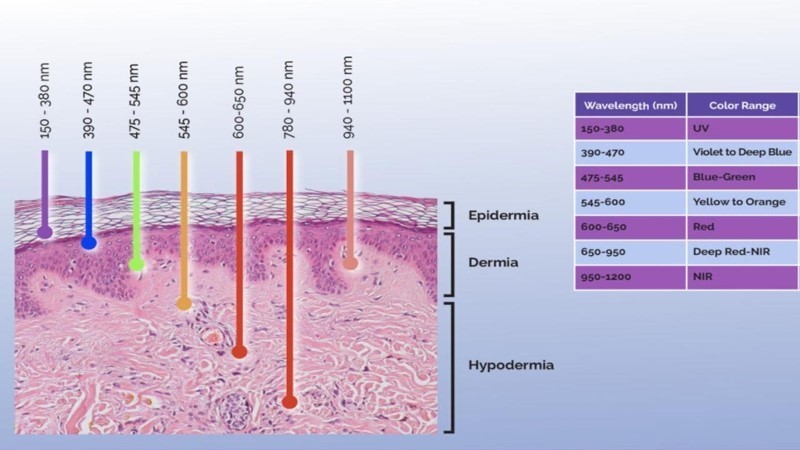Science
TrueLight® Science
Light therapy (also known as photobiomodulation, phototherapy, or LLLT) is a painless, non-invasive form of treatment that uses specific wavelengths of light to help heal the skin and body. It is safe for both humans and animals.
A Brief History
Modern light therapy is derived from “heliotherapy” — the therapeutic application of sunlight to treat health conditions. It’s one of the most ancient therapeutic measures employed by humans, and it’s believed that the ancient Greeks were the first people to use this method.
In 1903, Neils Finsen was awarded the Nobel Prize in Medicine for successfully illustrating that specific wavelengths of (ultraviolet) light could be used to treat people with Tuberculosis. Today, Finsen is recognized as the father of modern phototherapy, which has also proven to be effective in the fields of dermatology, neurology and physiotherapy.
In the 1960s, soon after the discovery of lasers, doctors realized that light therapy (using LEDs) could improve wound healing and reduce pain, inflammation and swelling (NCBI). NASA was the first to use this technology – initially for plant growth experiments in space, and then to promote human tissue growth. In clinical trials, LED light therapy successfully reduced the painful side effects of chemotherapy and radiation treatment in bone marrow and stem cell transplant patients. The studies conducted at this time were significant because they showed that this technology could essentially boost the primary energy processes in the mitochondria of every single cell in the body.

It was also around this time when scientists in Europe found that specific wavelengths of light had therapeutic effects on tissues of the body through a process called photo–stimulation. This process uses light to artificially activate biological compounds, cells, tissues, or even whole organisms. One example of using this process is “light-treating” babies for jaundice, a relatively common condition of newborns.
How Modern LED Light Therapy Works
Photobiomodulation is like photosynthesis for your skin and body; it essentially empowers damaged cells to heal themselves with the help of specific wavelengths of light, including visible light (400-700nm) and infrared light (700-1100nm). There are two key mechanisms of how light therapy benefits cellular function and overall health:
– Stimulating ATP production in the mitochondria
– Hormesis – the process of building up the anti-inflammatory, antioxidant and cell defense systems of the cell
Different colors of light also notably penetrate the skin with different intensities and can have numerous health benefits.

Red and Near-Infrared Light Therapy
Red, deep red, and near-infrared (NIR) are the most commonly used wavelengths of light, as they notably have the deepest penetration levels (8-10 millimeters into the skin). These are ideal for healing your body all the way down to the bone (think: muscle soreness or pain, post-surgery recovery, improved blood circulation). Possible benefits of Red and NIR light therapy can include:
– Faster muscle recovery
– Enhanced blood circulation
– Increased collagen production
– Reduces scars, wrinkles, & fine lines
– Faster wound healing
– Pain relief
– Anti-inflammatory effects
– Aid depression and anxiety
– Weight loss
– Improved brain function and mood
Studies show that 630nm and 660nm are the most effective red wavelengths for stimulating, healing and restoring your cellular health.
Near-infrared (850nm) is especially helpful when it comes to the regeneration of deeper structures such as tendons, bones, and cartilage; orthopedic and musculoskeletal problems. Near-infrared may also be useful for kidney problems. Anecdotal evidence suggests it could be a powerful therapy for kidney failure. (Dr. Mercola)
Yellow Light Therapy
Yellow (or amber) light therapy is often considered to be an ideal solution for sensitive skin with calming and soothing benefits. It encompasses the range of wavelengths from 570nm to 620nm. TrueLight devices specifically concentrate on the 580nm wavelength, which is ideal for creating primary cellular movement at the top layer of skin. Research shows that yellow light therapy may help with:
– Reducing fine lines, scars and wrinkles
– Improving skin hydration
– Treating inflammatory conditions such as rosacea and eczema
– Boosting lymphatic flow, which helps to remove toxins from treated areas of the body
– UV damage
– Flushing toxins from the skin
– Reducing redness and swelling
Yellow light therapy isn’t as well documented yet, but the studies that are available show that this is a safe and appropriate treatment for all skin types, including those that are the most sensitive and reactive.
Still Have Questions?
Still have questions? Check out our FAQs!
You can also find more studies about the effects of light therapy on human health here.

